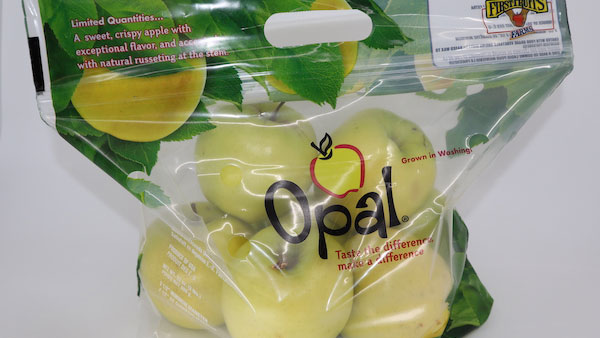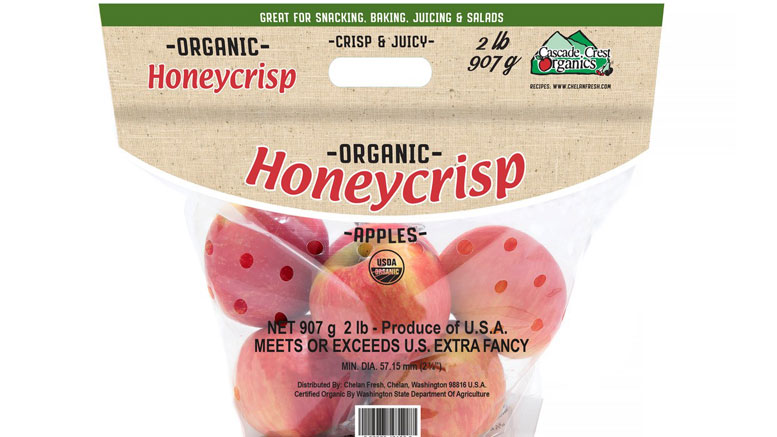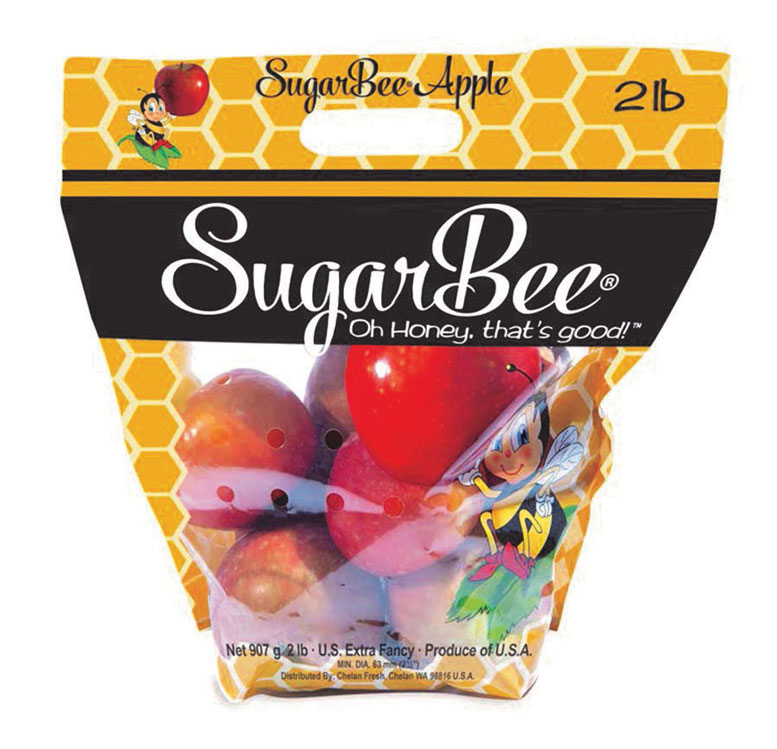Washington State Apples Are In The Bag
September 8, 2021 | 8 min to read
Consumer demand for pre-packaged fruit continues to rise, driven by trends in sustainability, convenience, and food safety, with the market forecasted to reach nearly $7 billion by 2024. In Washington State, where 69.5% of U.S. apples are produced, both bulk and bagged apples cater to diverse consumer preferences. Experts emphasize packaging’s role in promoting high-flavor varieties, while investment in automation suggests continued growth in produce packaging as shopping habits evolve.

Pre-packaged fruit are in line with omnichannel shopping habits, and offering both bulk and bag apples in stores appeals to different customers.
Originally printed in the August 2021 issue of Produce Business.
Consumers’ demand for fresh produce packaging isn’t new. Even before COVID arrived, a 2018 survey by the Annapolis, MD-headquartered Flexible Packaging Association showed shoppers’ desire for sustainability, convenience and food safety were driving more fresh fruits and vegetables into packs. Today, as the pandemic continues, packaging appeal is thriving, as these three factors remain top concerns.
The market for fresh produce packaging is forecast to grow 3.7% annually to nearly $7 billion in 2024, according to the April 2021 released Fresh Produce Packaging report from the Freedonia Group, a division of Rockville, MD-headquartered Marketresearch.com.
Produce packaging has long been a staple for small highly perishable fruits and vegetables. Think berries, fresh figs and mushrooms. Beyond this, even larger and less perishable items — like apples — traditionally sold in neatly stacked, eye-catching bulk displays are now seeing pack types proliferate.
This is true in Washington State, which produced over two-thirds (69.5%) of apples grown in the U.S. last year, according to data from the Washington State Tree Fruit Association (WSTFA), in Yakima. And it’s due to a trio of reasons, say experts.
First, growers are anticipating more smaller-sized fruit this season due to the heat earlier this summer, says Mac Riggan, director of marketing for Chelan Fresh, in Chelan, WA. “We’re potentially looking at an average of one size smaller.”

PHOTO COURTESY OF FOX PACKAGING
Second, Washington State is the largest domestic producer of organic apples.
“A larger number of organic apples is packed into bags due to their sizing,” says Chuck Sinks, president, sales and marketing, for Sage Fruit, in Yakima, WA. “Organic apples tend to grow a size smaller than their conventional counterparts. Rather than having a visual size difference on the retail shelf, the smaller apples tend to be packed in a consumer-friendly bag.”
Third, some 30 apple varieties are grown commercially in Washington State, according to the Wenatchee, WA-based Washington Apple Commission. Of these, over half are new trademarked or registered trademarked varieties not seen on retail shelves a decade or two ago. With less use of point-of-sale materials such as shelf talkers at retail, packaging can serve as a billboard for a product.
Overall, some 39% of the 2020-21 crop of Washington apples were sold in some type of consumer pack, up 8% over the 2018-2019 season, according to WSTFA.
“Packaging gives us a chance to tell the story, to entice shoppers to buy and try, especially high flavor proprietary varieties like Envy and Opal that typically cost more than mainstream varieties,” says Joe Vargas, marketing director for FirstFruits Marketing LLC, in Yakima, WA.
This is especially true of pouch bags.
“Brand owners take advantage of the pouch bags’ upright print space and use color schemes to differentiate conventional produce from organic produce,” says Craig Fox, vice president of Fox Packaging, in McAllen, TX. “Having apples in a convenient grab-and-go bag with high clarity allows allows consumers to choose what they perceive as the healthiest choice. Including the origin story of the item also strengthens that purchase decision.”
ON THE INCREASE
Overall, some 39% of the 2020-21 crop of Washington apples were sold in some type of consumer pack, up 8% over the 2018-2019 season, according to WSTFA survey data. On the organic side, roughly 34% of the fresh crop was in consumer packs for 2020-21, an increase of 7% since the 2018-19 crop.

“I think we might see some leveling of this bulk-to-bag ratio in the future, but think that packaging is going to increase in the future in produce as part of the omnichannel shopping habits that consumers have now adapted to,” says Brianna Shales, marketing director at Stemilt Growers LLC, in Wenatchee, WA. “Retailers are going to need solutions that work for brick-and-mortar stores and their online business, and fixed weight, pre-packaged fruit often provides that.”
Many of the state’s apple growers have made multimillion-dollar investments in their packing facilities with greater automation, says Tim Kovis, the WSTFA’s director of communications and events. “This will continue as more efficient and streamlined technology becomes available.”
Automation can be established in a nearly no-hands line setup, and equipment can serve companies in many unique and specific ways, says Fox.
SIZES MATTER
Bulk, or unpackaged, apples will always have a place on the shelf, says Sage Fruit’s Sinks. “This is how we pack a majority of our product — 40-pound, tray pack boxes. Consumers like to be able to have control over the number of apples or the number of pounds they are purchasing.”
The benefit of offering both bulk and bag apples is appealing to two different customers, says Jason Kazmirski, retail specialist for Charlie’s Produce, in Seattle, WA, which supplies several independent retailers in the Pacific Northwest as well as larger chains such as Fred Meyer and Sprouts. “The bulk is for customers who like a larger apple, and the bagged are a good snack-size or kid-sized fruit, and the latter especially appeal with kid-friendly graphics.”
Polybags or plastic pouches, especially high-graphic pouches, in various sizes are the predominant packages used for apples, according to Stemilt’s Shales. There are some mesh options out there, too.
“Due to the demand for high-graphic pouch bags, we’ve also incorporated several different sizes to accommodate our partners,” says Sage Fruit’s Sinks. “For instance, we now pack a 2-pound Honeycrisp pouch to hit a price point at the register that is more appealing to the consumer.”
Two-pound pouch bags of apples have really taken off, according to Charlie’s Produce Kazmirski. “It’s grown from a couple of cases to pallet boards over the last few years. We buy 2-pound pouches in everything from Granny Smith to Honeycrisp. What makes the 2-pound ideal is the fast turnover. Consumers finish the bag quickly and are back in store for more.”
“The bulk is for customers who like a larger apple, and the bagged are a good snack-size or kid-sized fruit, and the latter especially appeal with kid-friendly graphics.”
Jason Kazmirski, Charlie’s Produce
While 90 percent of apples are sold bulk at Tadych’s Econofoods, a six-store chain headquartered in Brillion, WI, the remaining 10 percent are displayed in 2- and 3-pound bags, says Jim Weber, produce supervisor. “We carry conventional apples in 3-pound and organic apples in 2-pound, because organic is more expensive.”
Like organic, 2-pound bags are often desired for new, costlier, proprietary apple varieties.
“Five-pound bags are also popular for mainline varieties like Gala.”
Higher weights, like 8- and 10-pound bags, are less likely to be seen in stores regularly and are often value items, according to Sage Fruit’s Sinks. “The 8- and 10-pound bags are typically poly.”
SUSTAINABILITY
There will always be demand for packaging, according to Rochelle Bohm, brand manager for CMI Orchards, in Wenatchee, WA. “The bigger question is ‘what kind?’ This continues to be an evolving conversation. Producers, retailers and consumers are more educated today about carbon footprint and this is driving changes in packaging.”
There are pros and cons to all packaging and even to packaging versus no packaging, says Chelan Fresh’s Riggan. “Pouch bags are popular, but sometimes not as recyclable. Right now, it’s all about choosing the lesser of two evils and keeping an eye toward packaging innovations in the future.”

Biodegradable has its challenges, too.
“One concern about biodegradable packaging is that it doesn’t biodegrade before we can use it to pack apples. We pack apples nearly year-round, whether from fresh harvest or out of controlled atmosphere storage,” says CMI Orchard’s Bohm.
A desire to eliminate pouch bags or club store clamshells are most requested for apples, says Sara Lozano, in marketing and product development at Sambrailo Packaging, in Watsonville, CA. “We have customized solutions for both types of these apple packages. Our design is diverse and can fit apples by the pound or by count.”
Similarly, the team at Fox Packaging has been reviewing pouch bag materials from a sustainability perspective. “Performance is key. Ideal materials do not require you to sacrifice sustainable properties,” says Fox. “We’ve been able to restructure the chemical performance properties of our films without impacting the recyclability of our product or the overall cost of a finished bag.”
Some Washington State apple growers are testing sustainable packaging on their other crops.
“Our initial trial in sustainable packaging was our organic cherry pouch bag during the 2021 season,” says Sage Fruit’s Sinks. “While we are currently seeking options for both our conventional and organic products, we felt that the organic consumer would be the best place to initiate a trial.”
The Sage Fruit bag uses Sev-Rend’s patent-pending Bio-Able Solutions. Enabled with bio-assimilation technology, these new bags are 100% recyclable and formulated to fully degrade in both marine and terrestrial environments, leaving behind zero micro-plastic waste, according to the manufacturer.
Going forward, adds Stemilt’s Shales, “we are going to see different materials be trialed to reduce the use of plastic, or see plastic move to recyclable options. It will take time to get there.”

